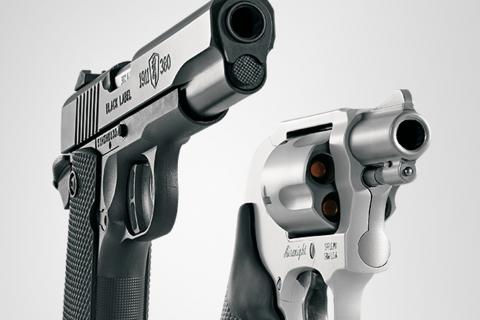
Deciding which ammunition you should choose for personal-defense situations should be carefully considered, after all, your life may truly depend upon the choices you make. But, before you start evaluating your ammo choices, you need to take an in-depth look at your handgun in order to make an educated decision.

Handguns
Handgun platforms have evolved dramatically during the last decade to become more "concealable" and "ergonomically friendly"; however one size still does not fit all. Your handgun should fit comfortably in your hand and it should feel like an extension of your arm. All of the controls (magazine release, slide release and safety), should all be able to be manipulated by your strong hand without having to change the grip on the gun. If you have to change your grip on the gun, or utilize your weak hand to operate these controls, the handgun is too large or too small to be considered for use as a defensive handgun.
Tip: Watch These Tips for Legal Gun Transportation

Once you have determined which handgun best fits your hand, you need to look at its barrel length. A full-sized handgun has an average barrel length of 4-1/2". If you are using a concealed- carry-sized handgun, you need to deduct approximately 60-100 fps of velocity for every inch in length your barrel is shorter than 4-1/2". If you combine a short barrel with a long rate of twist, you could be limiting the performance of your handgun ammunition.
I know – right now some of you are saying "rate of twist in a handgun?" I'm not shooting long distance, what difference does the rate of twist make?

The rate of twist in a handgun stabilizes the bullet and ensures that the bullet strikes "head on," which will maximize the effectiveness of the round. If the handgun has a long rate of twist, such as 1:16", your bullet may destabilize upon contact with a medium (clothing, drywall, plywood, glass) and not strike "head on," limiting the amount of damage to be caused only from the "yaw effect." The "yaw effect" is when a bullet tumbles, rather than expands, leading to a wound channel which is usually less dramatic than you would receive from an expanded bullet.
This could severely limit your ability to stop a deadly force threat when you need it the most. Now that we have started to have some insight into handgun and ammunition performance, let’s look at your ammunition choices.

Range Ammunition
Most range ammunition is just that, ammunition designed for use practicing on a range and not for personal defense. This category includes bullet designs such as wad cutters, encapsulated, full metal jackets, as well as frangible bullets. All of these work very well on steel and paper targets, but they perform poorly compared to the wide variety of defensive ammunition offered today.
Full metal jackets and other range ammunition primarily cause damage via the "yaw effect", which, as discussed, may not stop the threat. Since this ammunition design does not possess the ability to expand, it has a strong probability of over penetrating the intended target, leading to the possibility of a lawsuit for the end user.

Jacketed Hollow Point Bullets
Jacketed hollow points really started to evolve in the 1980's and 1990's. This was the next logical step in "cup and core" ammunition design and production. Hollow-point bullets were created by placing a jacket around a lead core, which had a recessed cavity in the center. This led to greater expansion and less penetration, but it still had its drawbacks. Due to the fact the jacket was only mechanically attached to the core, the jacket would often separate from the core (dependent on the medium). This separation could affect penetration depth and, once again, not stop the threat in a life or death situation.

Bonded Hollow Point Ammo
Bonded hollow-point ammunition was a solution developed in the 1990's to prevent the jacket and core from separating upon impact. The jacket is attached to the core through a process of electro or electro-chemical bonding. This reduced the ability of the jacket to separate from the core. However, in order for this process to work, the core must be made of pure lead. The problem with pure lead of course is it is extremely soft, which can lead to very rapid expansion without the desired penetration depth needed to stop a threat.
Bonding hollow-point ammunition managed to fix one of the problems that plagued its design, thus reducing jacket and core separation. However, it failed to address the primary problem all HP bullets face: possible plugging when shooting walls or other soft materials. It was this problem, which led to the next evolution in ammunition.
Watch These Tips for Legal Gun Transportation
- 37763 views

